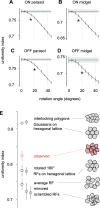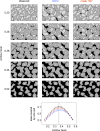Receptive fields in primate retina are coordinated to sample visual space more uniformly
- PMID: 19355787
- PMCID: PMC2672597
- DOI: 10.1371/journal.pbio.1000063
Receptive fields in primate retina are coordinated to sample visual space more uniformly
Abstract
In the visual system, large ensembles of neurons collectively sample visual space with receptive fields (RFs). A puzzling problem is how neural ensembles provide a uniform, high-resolution visual representation in spite of irregularities in the RFs of individual cells. This problem was approached by simultaneously mapping the RFs of hundreds of primate retinal ganglion cells. As observed in previous studies, RFs exhibited irregular shapes that deviated from standard Gaussian models. Surprisingly, these irregularities were coordinated at a fine spatial scale: RFs interlocked with their neighbors, filling in gaps and avoiding large variations in overlap. RF shapes were coordinated with high spatial precision: the observed uniformity was degraded by angular perturbations as small as 15 degrees, and the observed populations sampled visual space with more than 50% of the theoretical ideal uniformity. These results show that the primate retina encodes light with an exquisitely coordinated array of RF shapes, illustrating a higher degree of functional precision in the neural circuitry than previously appreciated.
Conflict of interest statement
Competing interests. The authors have declared that no competing interests exist.
Figures






References
Publication types
MeSH terms
Grants and funding
LinkOut - more resources
Full Text Sources
Other Literature Sources
Research Materials

